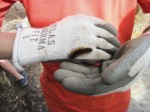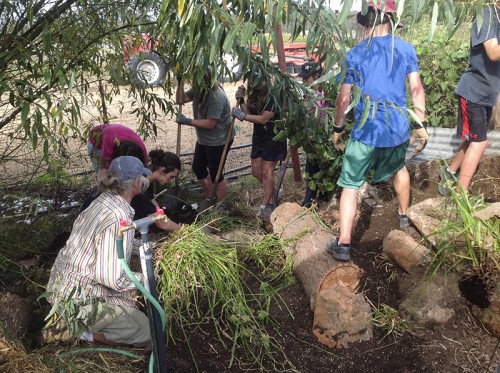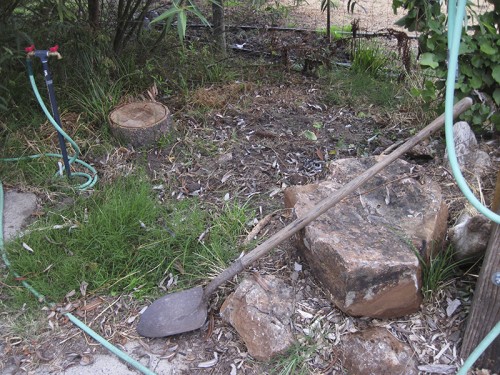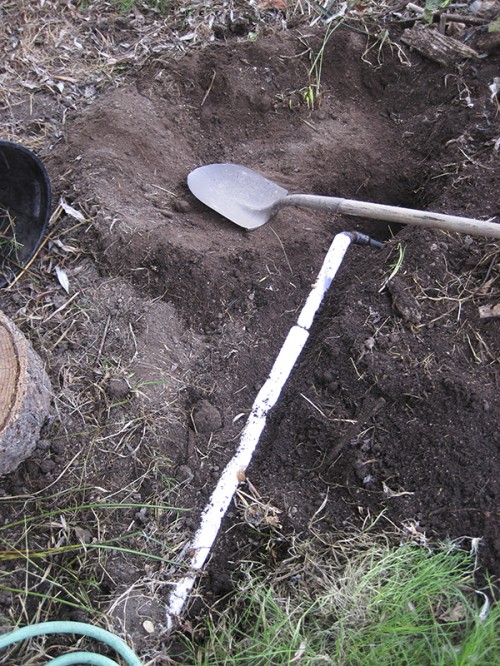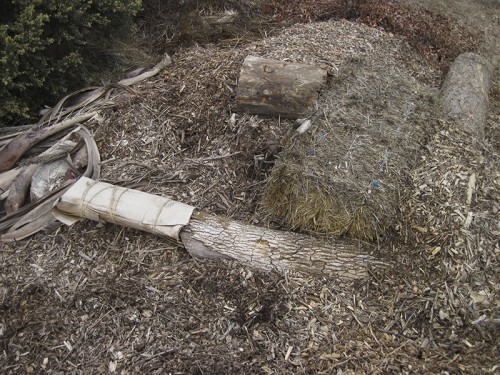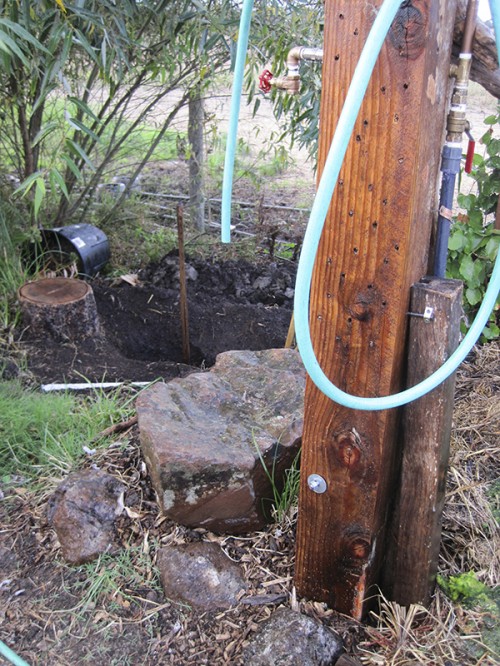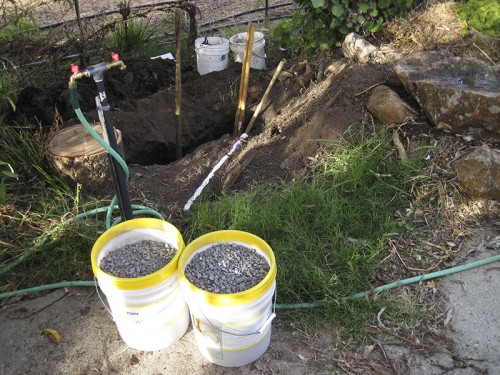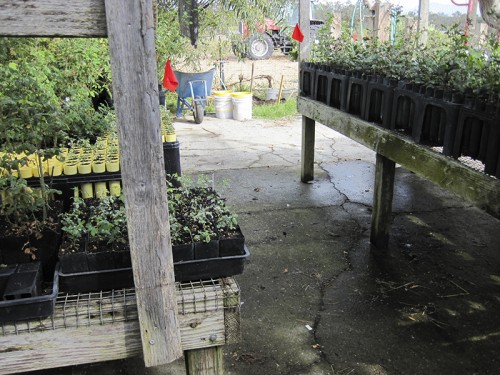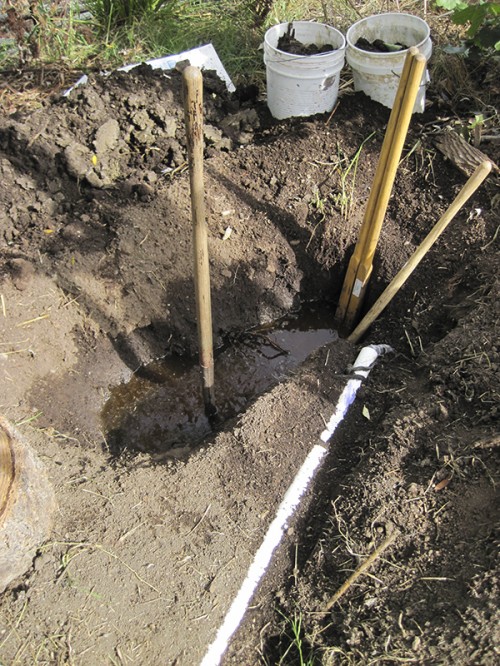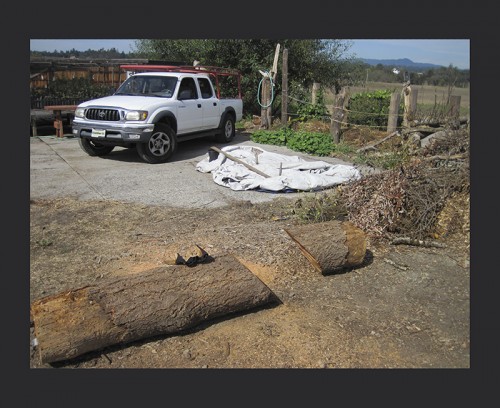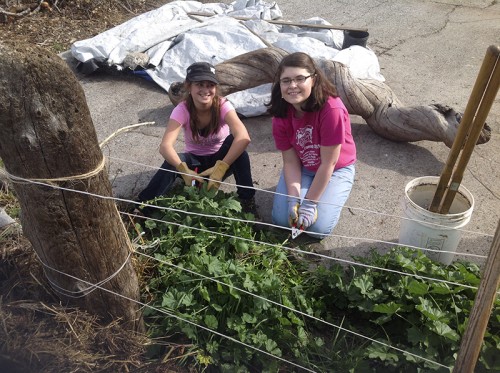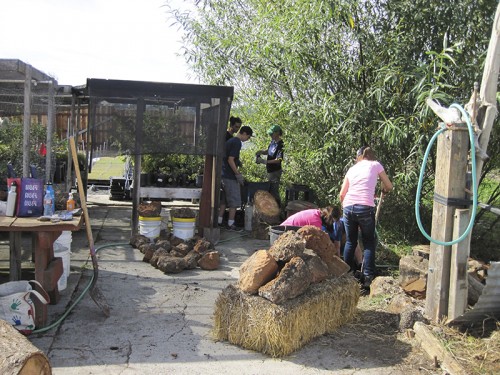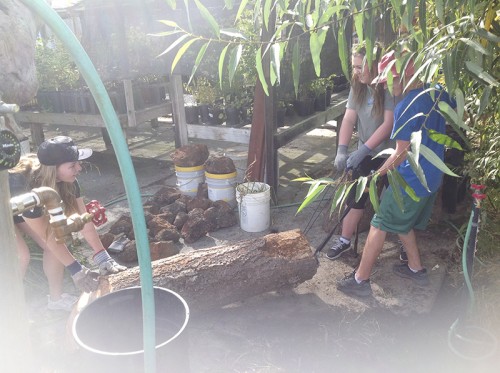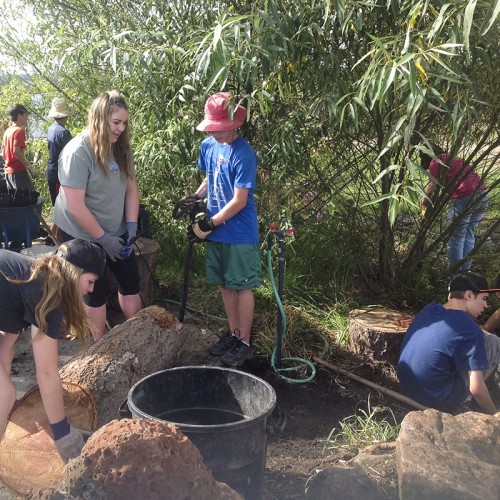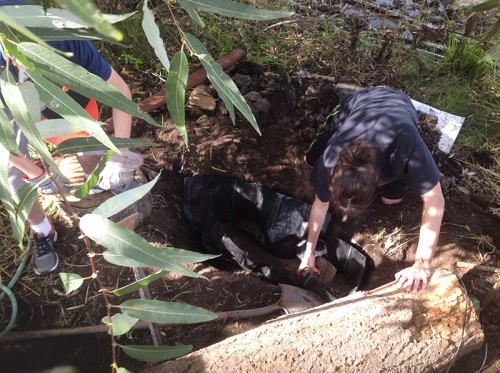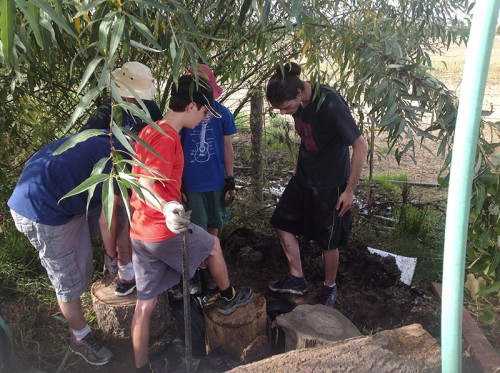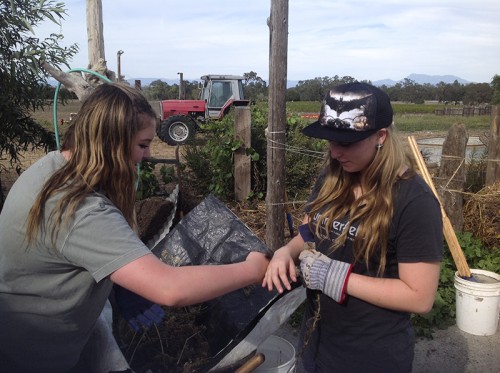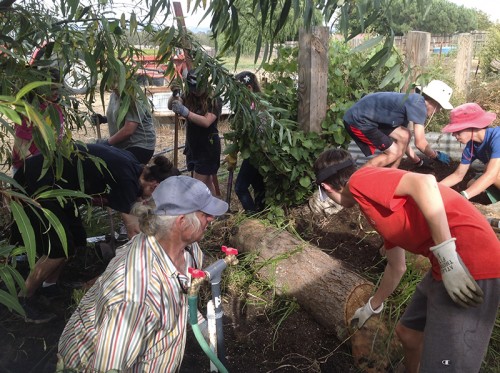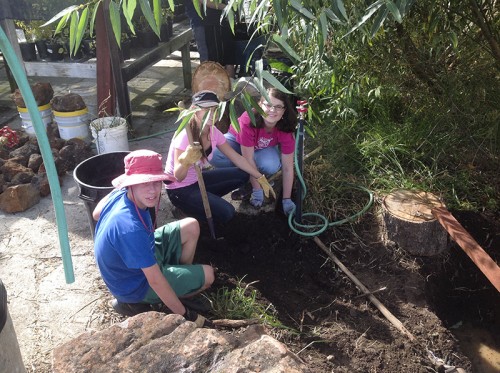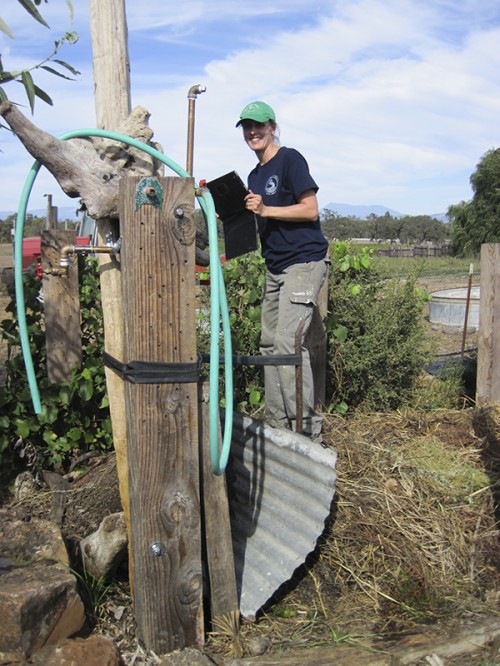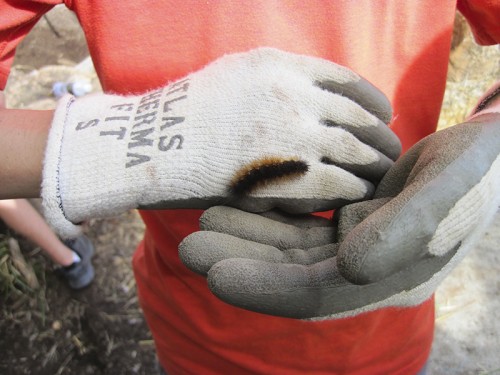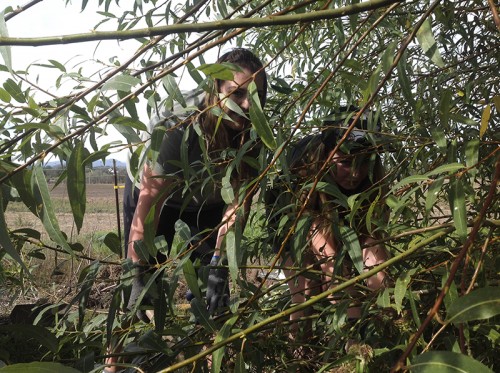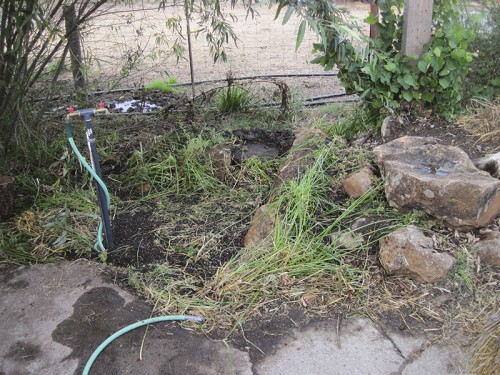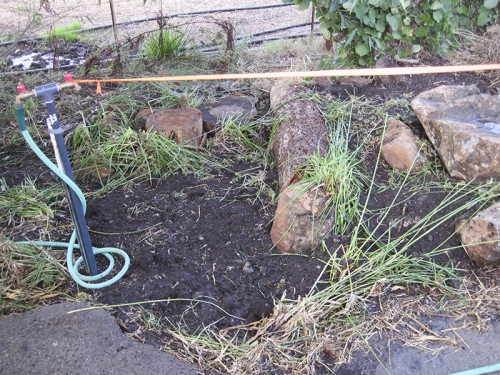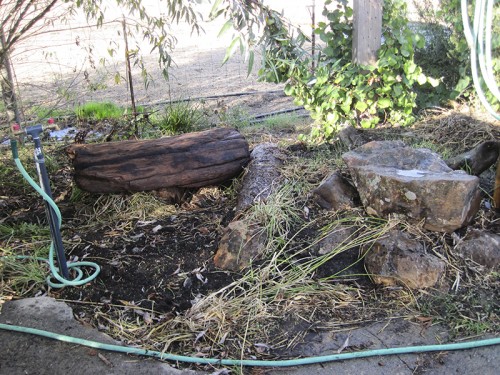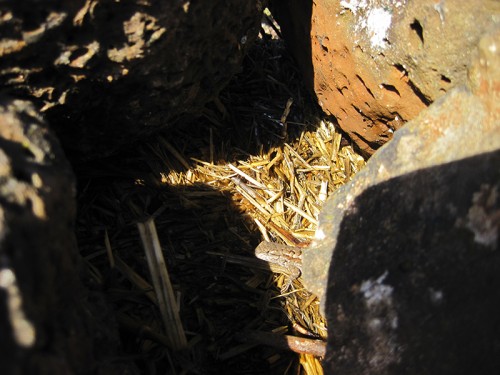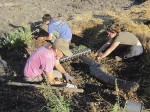
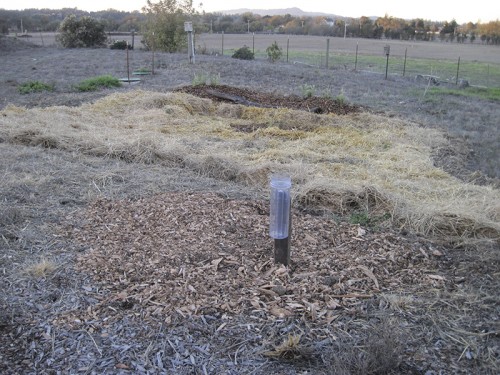 Science Station Shelf, in the foreground with its rain gauge ready to be read, was one of two wildlife habitat installations to be installed during November’s outdoor classroom Biology class at the Laguna Environmental Center. The Biology students from Orchard View School and teacher Sunny Galbraith also installed Amphibian Amphitheatre Hollow, at the edge of the straw mulch, in the background. Date of installations: November 12, 2015.
Science Station Shelf, in the foreground with its rain gauge ready to be read, was one of two wildlife habitat installations to be installed during November’s outdoor classroom Biology class at the Laguna Environmental Center. The Biology students from Orchard View School and teacher Sunny Galbraith also installed Amphibian Amphitheatre Hollow, at the edge of the straw mulch, in the background. Date of installations: November 12, 2015.
The Laguna de Santa Rosa Foundation operates the Laguna Environmental Center, or LEC, on Stone Farm, at 900 Sanford Road, Santa Rosa, California, 95401. These wildlife habitat installations are in an open grassy area behind Heron Hall and east of the pond.
Prep (before students)
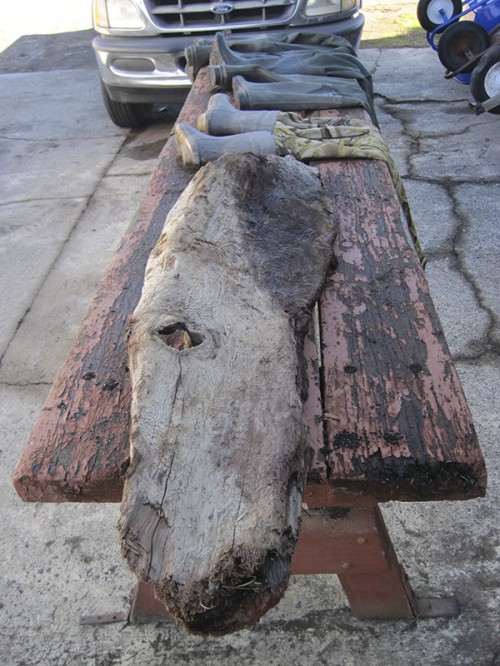 Objective Number One: Install a rain gauge. Use a large slab of wood to support the rain gauge post AND provide an underground shelter for critters. Project: Science Station Shelf.
Objective Number One: Install a rain gauge. Use a large slab of wood to support the rain gauge post AND provide an underground shelter for critters. Project: Science Station Shelf.
Wendy Trowbridge, Director of the Restoration and Science Programs, wanted a rain gauge to be installed behind Heron Hall in an easily accessible place to be read daily. The rain gauge manufacturer, Productive Systems, gives specific instructions how to install the gauge. To start, the rain gauge is to be mounted on a post 20 inches above ground level AND the post is to have a 45-degree angle cut at the the top — the surface angle reduces raindrop splashback. No splashbacks! The slab of redwood pictured above will support the post while being buried in the shallow slope of soil behind Heron Hall. Critters will find their way under and use the “shelf” in the soil as shelter. Also, the wood slab will wick moisture long after the topsoil is dry. Habitat it! Note the square-like hole in the wood knothole — perfect for a post!
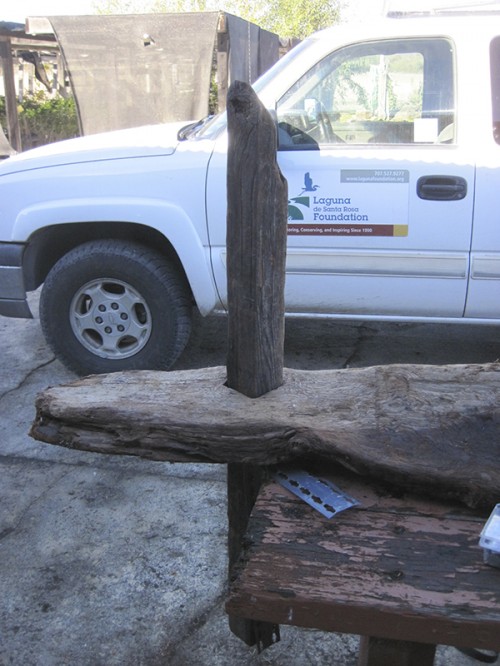 The original square-like hole in the redwood driftwood is fine tuned to accept the rain gauge post. Scrap metal is fashioned into a bracket to secure the post’s height through the post hole. We want the post tip 20″ above the ground + 3″ for soil/mulch to cover the wood base = 23″ of post length through the wood slab base.
The original square-like hole in the redwood driftwood is fine tuned to accept the rain gauge post. Scrap metal is fashioned into a bracket to secure the post’s height through the post hole. We want the post tip 20″ above the ground + 3″ for soil/mulch to cover the wood base = 23″ of post length through the wood slab base.
Objective Number Two: Replace a thriving weed bog with a planting of native sedge and rushes. Also, install a swale/berm that will collect water for the plantings. AND, partially bury a hollow log in the swale to provide moist habitat for amphibians and other animals. Project: Amphibian Amphitheatre Hollow.
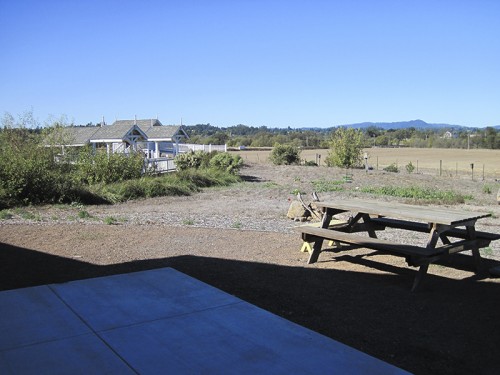 As can be seen from behind Heron Hall, most of the terrain is dry this time of year. The wet/green areas are irrigated, like around the pond (left) and behind the back wire link fence. Cow pasture is beyond the back (north) fence. The area we are concerned about for the wildlife habitat installation, Amphibian Amphitheatre, is the rich, thriving weedy area behind the picnic table (in the above photo). The moisture is most likely seepage from the pond to the west — water working its way through the soil berm that makes up the bank of the pond. This habitat installation will capitalize on that moisture.
As can be seen from behind Heron Hall, most of the terrain is dry this time of year. The wet/green areas are irrigated, like around the pond (left) and behind the back wire link fence. Cow pasture is beyond the back (north) fence. The area we are concerned about for the wildlife habitat installation, Amphibian Amphitheatre, is the rich, thriving weedy area behind the picnic table (in the above photo). The moisture is most likely seepage from the pond to the west — water working its way through the soil berm that makes up the bank of the pond. This habitat installation will capitalize on that moisture.
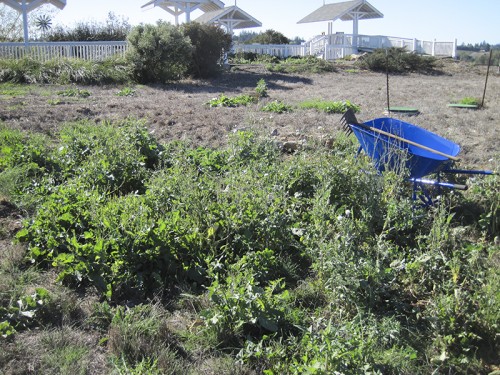 Plants are thriving here. Too bad for us they are classified as weeds — undesirable plants. They will be replaced to make way for native plants to encourage native wildlife. Too many to pull! So, instead, the McCloud tool, (on wheelbarrow, will rake them to the side. The bulk of the greens/roots, and loose soil will be used to shape a swale on the downhill side of the gently sloping terrain. Sounds easier to do than to actually drag the McCloud and rip out the weeds!
Plants are thriving here. Too bad for us they are classified as weeds — undesirable plants. They will be replaced to make way for native plants to encourage native wildlife. Too many to pull! So, instead, the McCloud tool, (on wheelbarrow, will rake them to the side. The bulk of the greens/roots, and loose soil will be used to shape a swale on the downhill side of the gently sloping terrain. Sounds easier to do than to actually drag the McCloud and rip out the weeds!
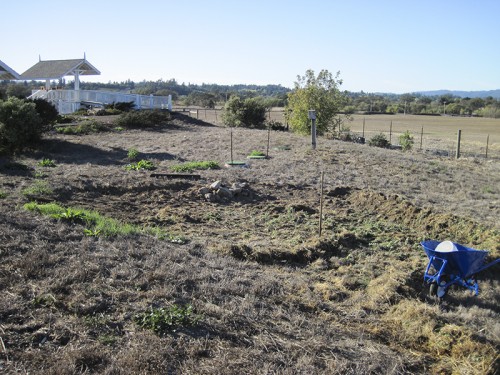 Many weeds have been scraped from the belly of Amphibian Amphitheatre. Note the berms of built up weeds and soil to the east and north. Also note the rock pile on the western edge of the shallow bowl — that is the pond outlet (overflow pipe outlet) . The rock pile hides the 4-inch PVC pipe that allows the pond to overflow if the pond level gets to a certain height (the height of the pond outlet flow pipe at the pond’s edge). So, in a high-volume rain, this low area will receive not only rainwater from the sky and rainwater flowing down the slope of soil, but also rainwater from the pond’s overflow pipe. That is a lot of water!
Many weeds have been scraped from the belly of Amphibian Amphitheatre. Note the berms of built up weeds and soil to the east and north. Also note the rock pile on the western edge of the shallow bowl — that is the pond outlet (overflow pipe outlet) . The rock pile hides the 4-inch PVC pipe that allows the pond to overflow if the pond level gets to a certain height (the height of the pond outlet flow pipe at the pond’s edge). So, in a high-volume rain, this low area will receive not only rainwater from the sky and rainwater flowing down the slope of soil, but also rainwater from the pond’s overflow pipe. That is a lot of water!
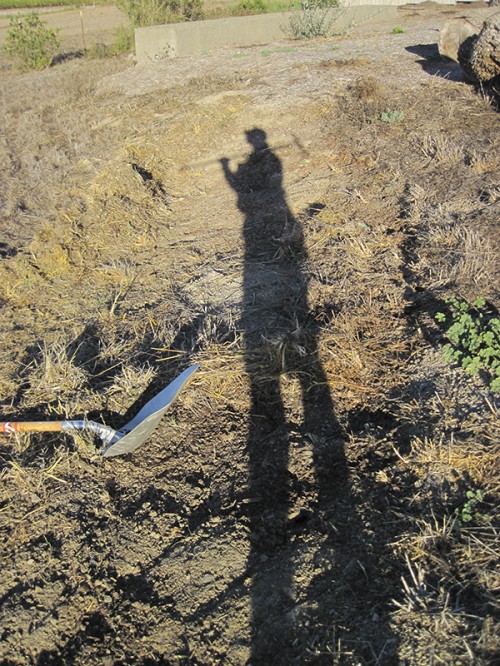 It’s been a long day! Amphibian Amphitheatre is nearly scraped and shaped. The topsoil was generously scraped to more easily remove weeds and to also bulk up the berm that will surround the low area and help catch water flowing on the gentle hillside.
It’s been a long day! Amphibian Amphitheatre is nearly scraped and shaped. The topsoil was generously scraped to more easily remove weeds and to also bulk up the berm that will surround the low area and help catch water flowing on the gentle hillside.
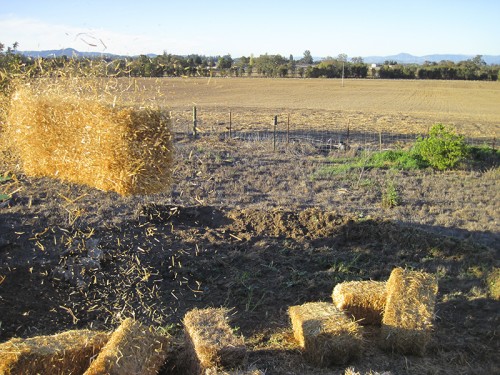 Bales of straw were tossed off of Stuart Schroeder’s hay wagon into Amphibian Amphitheatre. Broken up, and mulched, the loose straw will keep weeds at bay until the intended native plants can get a foothold. Also, the straw will wick moisture to the seedling native plants. Time will transform the straw into nutrients for the new native plants.
Bales of straw were tossed off of Stuart Schroeder’s hay wagon into Amphibian Amphitheatre. Broken up, and mulched, the loose straw will keep weeds at bay until the intended native plants can get a foothold. Also, the straw will wick moisture to the seedling native plants. Time will transform the straw into nutrients for the new native plants.
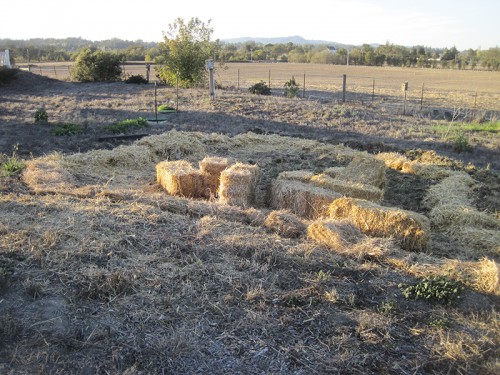 Straw used to smoother out long-established weeds.
Straw used to smoother out long-established weeds.
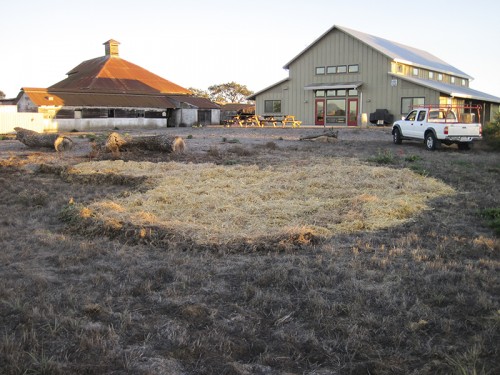 “The Swimming Pool” — A thin layer of straw mulch interior AND a curvy thick edge on the downhill slope, made of straw “blocks”, against the weed/scraped soil berm. We kept the straw and the berm next to each other to smother out weds BUT did not mix the two material edges. We want as much of the soil on hand in the berm to receive either native plant starts or seeds.
“The Swimming Pool” — A thin layer of straw mulch interior AND a curvy thick edge on the downhill slope, made of straw “blocks”, against the weed/scraped soil berm. We kept the straw and the berm next to each other to smother out weds BUT did not mix the two material edges. We want as much of the soil on hand in the berm to receive either native plant starts or seeds.
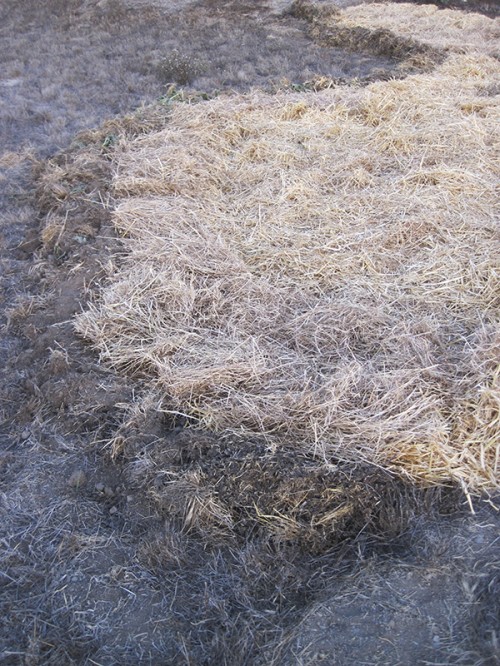 The downslope berm of Amphibian Amphitheatre designed to flow with the gradient of the slope. The objective in the curvy edge is to simulate the slope’s high-water mark where flood debris would have created a berm over the years. Ultimately, the berm’s exact location will become hidden under a field of native sedges, rushes, grasses, and flowers. Till then, we pull weeds!
The downslope berm of Amphibian Amphitheatre designed to flow with the gradient of the slope. The objective in the curvy edge is to simulate the slope’s high-water mark where flood debris would have created a berm over the years. Ultimately, the berm’s exact location will become hidden under a field of native sedges, rushes, grasses, and flowers. Till then, we pull weeds!
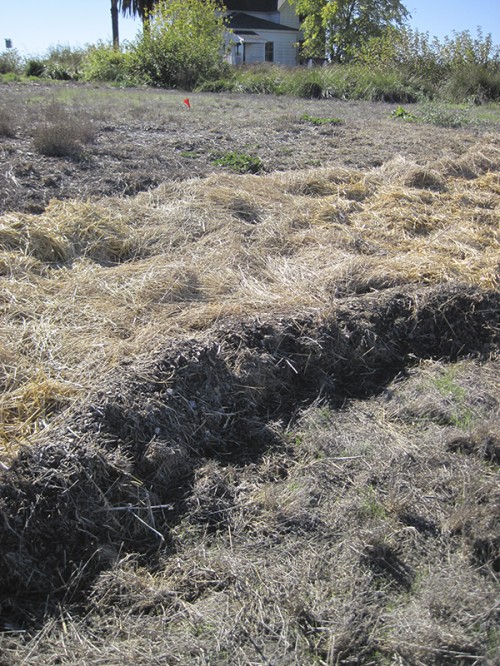 Northern, downhill, side of Amphibian Amphitheatre. Note the mix of weeds and soil in the berm and the homogenous, straw-only mulch layer. Time will tell how effective the mat of straw is to thwart weeds that where established, yet scraped into the berm. No chemicals used for all those weeds removed is a great plus. Poor native plant germination (from seed), high mortality rate of native plant transplants, and excessive maintenance will offset the enlightened non-use of chemicals — EVERYTHING has its costs. But rarely do critters get to weigh in — and my critter friends tell me that they would rather start with no chemicals.
Northern, downhill, side of Amphibian Amphitheatre. Note the mix of weeds and soil in the berm and the homogenous, straw-only mulch layer. Time will tell how effective the mat of straw is to thwart weeds that where established, yet scraped into the berm. No chemicals used for all those weeds removed is a great plus. Poor native plant germination (from seed), high mortality rate of native plant transplants, and excessive maintenance will offset the enlightened non-use of chemicals — EVERYTHING has its costs. But rarely do critters get to weigh in — and my critter friends tell me that they would rather start with no chemicals.
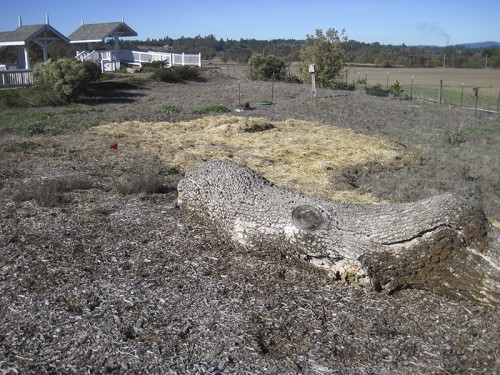 The straw has sat on Amphibian Amphitheatre for one week, a rain has come and gone, Wendy Trowbridge has marked, via red flag, the position of Science Station Shelf. Systems are go!
The straw has sat on Amphibian Amphitheatre for one week, a rain has come and gone, Wendy Trowbridge has marked, via red flag, the position of Science Station Shelf. Systems are go!
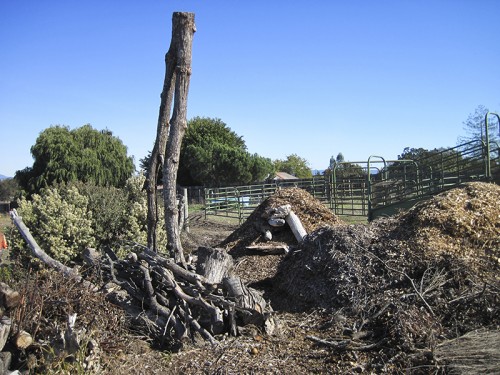
Amphibian Amphitheatre Hollow has been stored under the woodchip pile (center, back) beyond Garter Snake Ravine ( left) and Log Pile Apartments (far left). The hollowed-out log has been dutifully awaiting transfer papers into a wildlife habitat installation. Today is its lucky day! Storing such wildlife habitat installation materials in an active, fungal spore-rich medium, like wood chips, increases the chances that a living log will be delivered to the wildlife habitat. Why not start with ALIVE?!
Students at work
Science Station Shelf
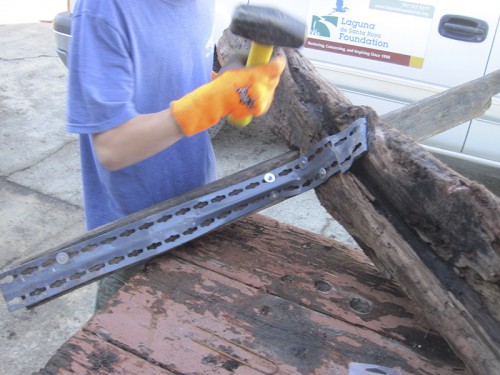 A student arrives in time to sledge hammer an angle bracket in place. The discarded shelving hardware is perfect to secure the rain gauge post to the redwood slab of wood. Sure beats sittin’ around the class!
A student arrives in time to sledge hammer an angle bracket in place. The discarded shelving hardware is perfect to secure the rain gauge post to the redwood slab of wood. Sure beats sittin’ around the class!
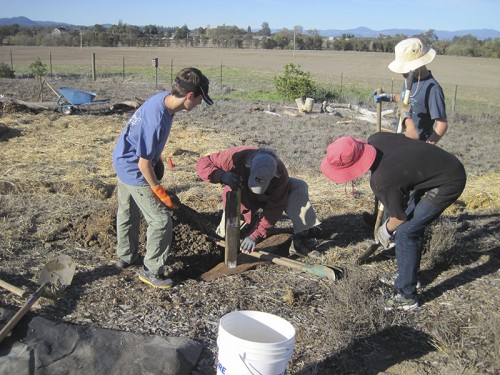 Using post hole diggers to determine ground level, we measure how far to dig Science Station Shelf into the ground. The top of the post must be 20″ above the restored woodchip-covered ground.
Using post hole diggers to determine ground level, we measure how far to dig Science Station Shelf into the ground. The top of the post must be 20″ above the restored woodchip-covered ground.
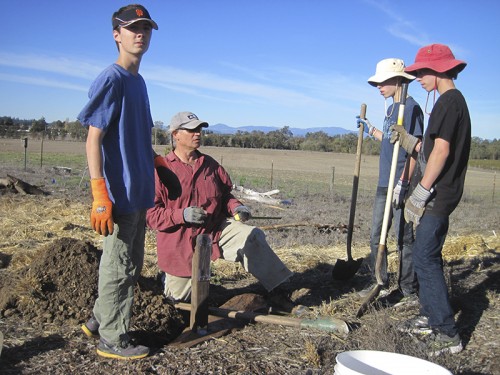 The crew stops to listen for birds. Was that a Black Crowned Night Heron on its way back to the Laguna?
The crew stops to listen for birds. Was that a Black Crowned Night Heron on its way back to the Laguna?
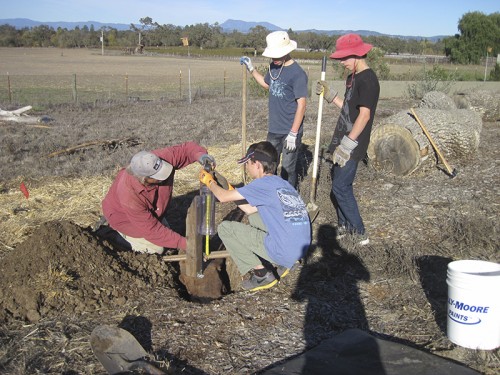 Measuring height of the top of the installed rain gauge. Perfect! Let the rain come.
Measuring height of the top of the installed rain gauge. Perfect! Let the rain come.
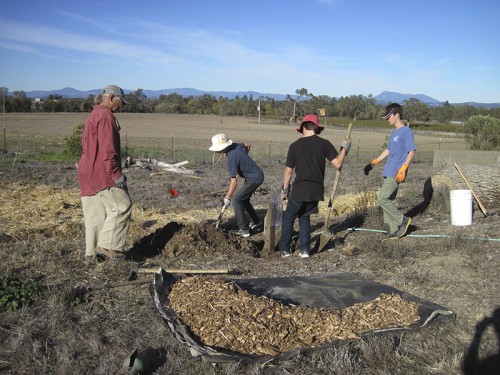 Time to bury Science Station Shelf with returning topsoil, new and old woodchips. Note how the new resource, the woodchips on the tarp in the foreground, will be used directly over the wood shelf. The tarp will keep the new-look of the chips from disturbing the immediate area.
Time to bury Science Station Shelf with returning topsoil, new and old woodchips. Note how the new resource, the woodchips on the tarp in the foreground, will be used directly over the wood shelf. The tarp will keep the new-look of the chips from disturbing the immediate area.
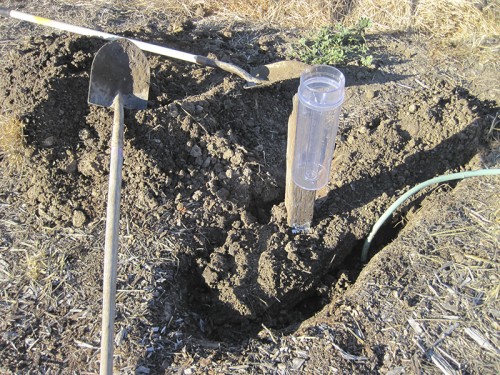 A good mud pile of the site ensures that the wood shelf will be “cemented” in place. Normally, best not to make mud, and drive oxygen out of the soil, but this shelf must be solid — scientists will be collecting rain gauge data daily. We want to ensure that they have sure footing on the shelf AND we do not want the rain gauge post to move at all. Mud is the answer!
A good mud pile of the site ensures that the wood shelf will be “cemented” in place. Normally, best not to make mud, and drive oxygen out of the soil, but this shelf must be solid — scientists will be collecting rain gauge data daily. We want to ensure that they have sure footing on the shelf AND we do not want the rain gauge post to move at all. Mud is the answer!
Amphibian Amphitheatre Hollow
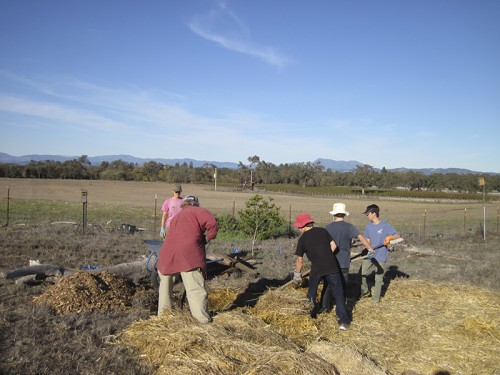 Pulling back the straw mulch from the inside of the berm to give us plenty of room to work. We want to get down to the soil to trench in a ten-foot hollow log, partially buried. Sedge and rush plants will grow alongside the water-wicking log and critters will have a long wood Quonset hut for shelter, for habitat.
Pulling back the straw mulch from the inside of the berm to give us plenty of room to work. We want to get down to the soil to trench in a ten-foot hollow log, partially buried. Sedge and rush plants will grow alongside the water-wicking log and critters will have a long wood Quonset hut for shelter, for habitat.
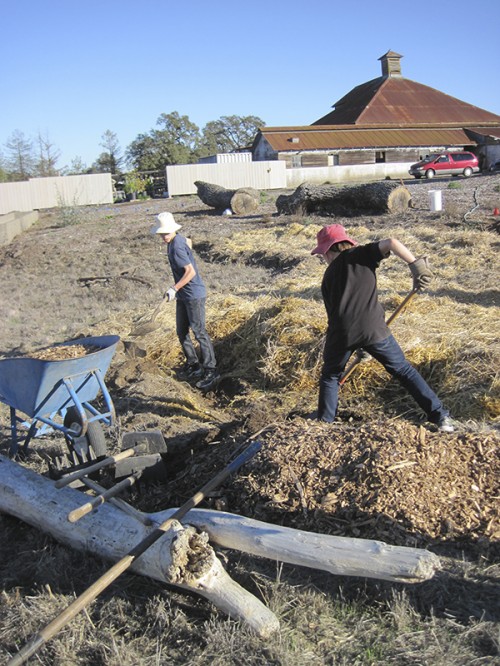 The tree trunk section has been dropped into position for placement alongside the berm, and now rests alongside while habitat landscapers dig the trench that the wood will rest in. Shovelful by shovelful, the wildlife habitat comes into being. Note the woodchips on-hand; they will be used to dress the mugwort and sedge plantings. Note how the berm curves in the distance.
The tree trunk section has been dropped into position for placement alongside the berm, and now rests alongside while habitat landscapers dig the trench that the wood will rest in. Shovelful by shovelful, the wildlife habitat comes into being. Note the woodchips on-hand; they will be used to dress the mugwort and sedge plantings. Note how the berm curves in the distance.
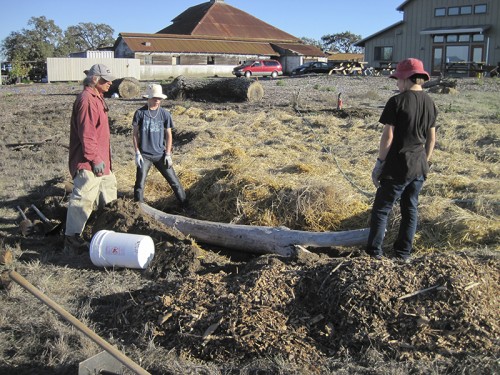 Decision time — have we dug enough? Will the wood log sit snuggly in the berm? Is there a welcoming entrance to the log’s hollow? Does the log look good in the hole? All answers = maybe! Note the displaced soil from the trench — a beautiful new resource to have for the plantings.
Decision time — have we dug enough? Will the wood log sit snuggly in the berm? Is there a welcoming entrance to the log’s hollow? Does the log look good in the hole? All answers = maybe! Note the displaced soil from the trench — a beautiful new resource to have for the plantings.
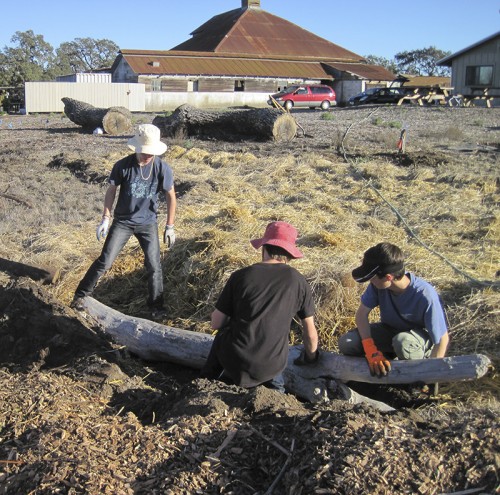 Yay, we are done digging. Amphibian Amphitheatre Hollow is in place.
Yay, we are done digging. Amphibian Amphitheatre Hollow is in place.
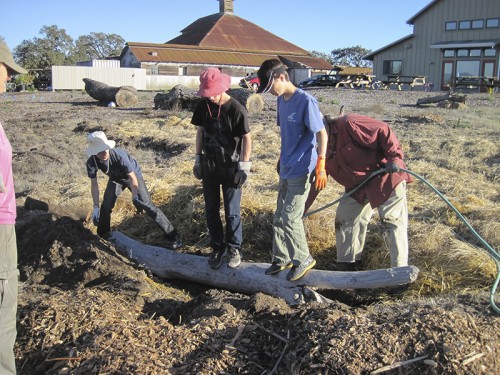 Mudding in The Hollow. Students stand on the log to sink it into the mud cast being made for it. Easy work, if you can get it.
Mudding in The Hollow. Students stand on the log to sink it into the mud cast being made for it. Easy work, if you can get it.
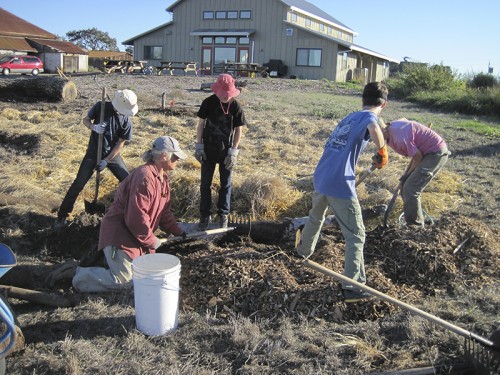 Shaping soil alongside the log and grading the berm.
Shaping soil alongside the log and grading the berm.
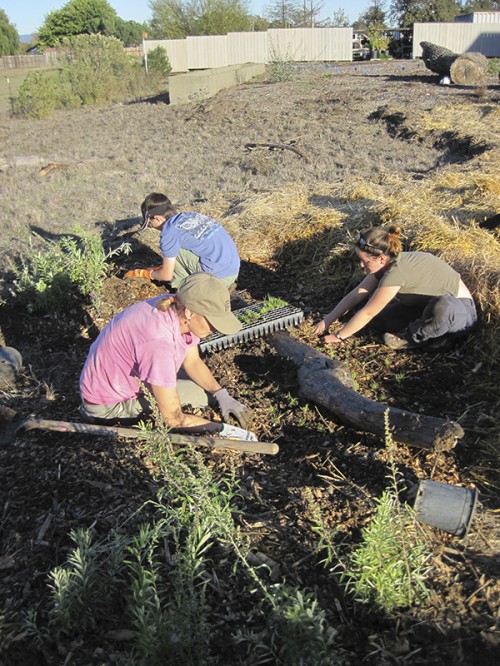 Planting umbrella sedge (Cyperus eragrostis) starts from one of the Nursery trays; the flat of sedge starts is sitting on top of the partially buried Hollow log. The sedge will grow together tightly, providing a thick cover for critters. Also, 2 clumps (of 5 plants each) of mugwort, Artemisia douglasiana, were planted on the berm (foreground and left in photo). Critters will enjoy the mugwort seeds and the plants’ insectary nature will help keep the LEC buzzin’. How wonderful that the Laguna Foundation grew these plants on site in the Native Plant Nursery!
Planting umbrella sedge (Cyperus eragrostis) starts from one of the Nursery trays; the flat of sedge starts is sitting on top of the partially buried Hollow log. The sedge will grow together tightly, providing a thick cover for critters. Also, 2 clumps (of 5 plants each) of mugwort, Artemisia douglasiana, were planted on the berm (foreground and left in photo). Critters will enjoy the mugwort seeds and the plants’ insectary nature will help keep the LEC buzzin’. How wonderful that the Laguna Foundation grew these plants on site in the Native Plant Nursery!
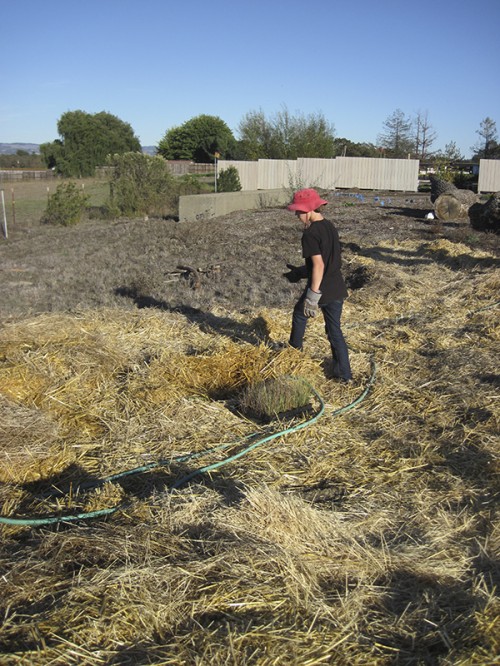 A student prepares to plant out a flat of juncus patens, or California grey rush. Juncus, like the nutsedge, can be periodically flooded; therefore, both plants are classified as semi-emergent species.
A student prepares to plant out a flat of juncus patens, or California grey rush. Juncus, like the nutsedge, can be periodically flooded; therefore, both plants are classified as semi-emergent species.
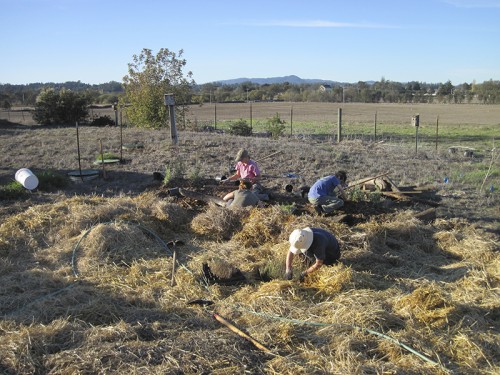 Everyone has a job — the plants go in quickly.
Everyone has a job — the plants go in quickly.
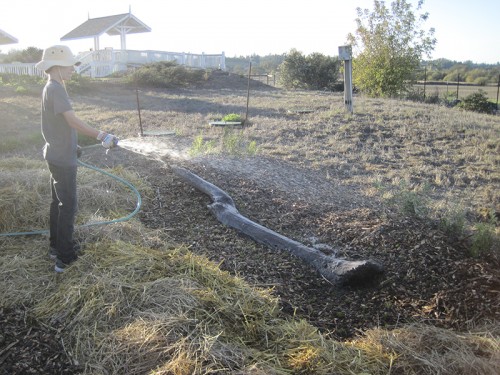 Amphibian Amphitheater Hollow gets watered in. Note the flare, a remnant from the tree trunk’s crown section, in the foreground.
Amphibian Amphitheater Hollow gets watered in. Note the flare, a remnant from the tree trunk’s crown section, in the foreground.
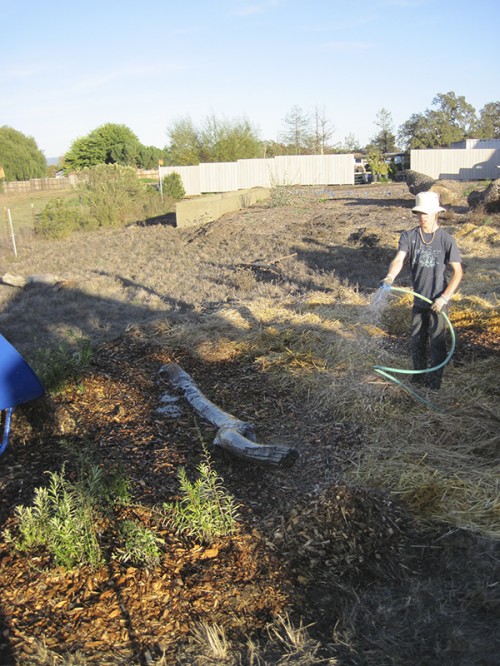 Happy watered wildlife habitat.
Happy watered wildlife habitat.
![OPEN OPEN OPEN [flashing sign, Main Street, Critterville]](http://sporelore.com/wp-content/uploads/2015/11/20151112-LF-AAH-f2-800-500x375.jpg) Close-up of The Hollow’s above ground entrance. All critters welcomed! This “subway” tunnel ends at, is a way to get to, the buried, cool, damp, night-dark soil of the berm. “Thanks for stopping by. What’s for lunch? Oh, you ARE lunch!” [Hungry Snake].
Close-up of The Hollow’s above ground entrance. All critters welcomed! This “subway” tunnel ends at, is a way to get to, the buried, cool, damp, night-dark soil of the berm. “Thanks for stopping by. What’s for lunch? Oh, you ARE lunch!” [Hungry Snake].
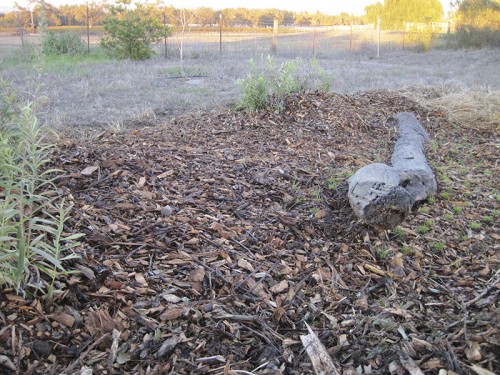 Berm (left) — Amphibian Amphitheatre Hollow (center) — Amphibian Amphitheatre (right). Note the small rise/hill to the berm. Water draining downslope (from the right) or filling Amphibian Amphitheatre (from the pond overflow pipe) will pool at the base of the log up against the berm. Also note that the mugwort is given a dryer soil height than the sedge, which thrives from periodic submergence. [3 years future, during a heavy flooding rain]: A great blue heron walks the log looking for critters flooded out from under Amphibian Amphitheatre’s meadow.
Berm (left) — Amphibian Amphitheatre Hollow (center) — Amphibian Amphitheatre (right). Note the small rise/hill to the berm. Water draining downslope (from the right) or filling Amphibian Amphitheatre (from the pond overflow pipe) will pool at the base of the log up against the berm. Also note that the mugwort is given a dryer soil height than the sedge, which thrives from periodic submergence. [3 years future, during a heavy flooding rain]: A great blue heron walks the log looking for critters flooded out from under Amphibian Amphitheatre’s meadow.
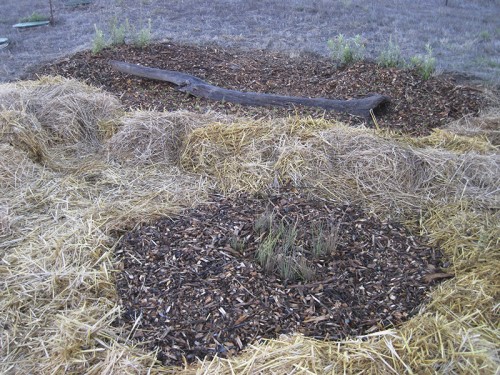 Habitat landscapers were here! Juncus patens (foreground), nutsedge (surrounding The Hollow), and mugwort (in berm, ends of The Hollow). Note how heavily the bunching of juncus was mulched with woodchip and surrounding straw. While the 2-3 years that the woodchips break down, the juncus will have gained a head start on competitor weeds. Also, the mulch will gather and wick moisture to the juncus transplants to bridge dry spells. The sedge and mugwort plants are equally heavily mulched.
Habitat landscapers were here! Juncus patens (foreground), nutsedge (surrounding The Hollow), and mugwort (in berm, ends of The Hollow). Note how heavily the bunching of juncus was mulched with woodchip and surrounding straw. While the 2-3 years that the woodchips break down, the juncus will have gained a head start on competitor weeds. Also, the mulch will gather and wick moisture to the juncus transplants to bridge dry spells. The sedge and mugwort plants are equally heavily mulched.
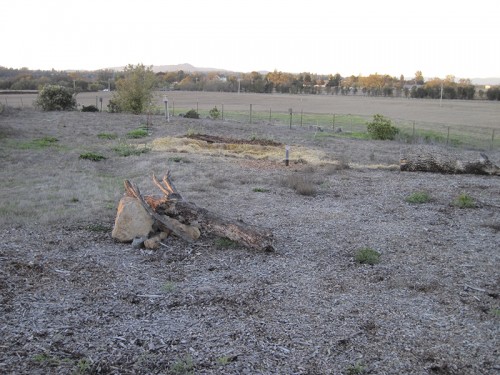 Done! 2 wildlife habitats installed AND the Laguna Environmental Center has a new rain gauge and outdoor thermometer. Nice job!, Sunny and your students, and long-time habitat landscaper helper, and me, Tony McGuigan.
Done! 2 wildlife habitats installed AND the Laguna Environmental Center has a new rain gauge and outdoor thermometer. Nice job!, Sunny and your students, and long-time habitat landscaper helper, and me, Tony McGuigan.
Final Touches (after students)
Science Station Shelf
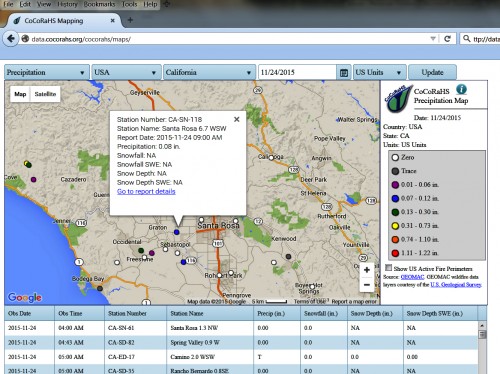 Wendy Trowbridge provided this link — the gathering place for daily country-wide rain gauge stations, which the LEC is now one of. The floating text/data box explains the blue dot — the daily data of the LEC’s station (Santa Rosa 6.7 WSW). November 24, 2015’s dot is blue because the Laguna Foundation’s Rain-Data-Scientist-of-the-Day (anonymity granted!) recorded 0.08 inches of rain that day. Rain! Glorious rain giving the LEC a good soak.
Wendy Trowbridge provided this link — the gathering place for daily country-wide rain gauge stations, which the LEC is now one of. The floating text/data box explains the blue dot — the daily data of the LEC’s station (Santa Rosa 6.7 WSW). November 24, 2015’s dot is blue because the Laguna Foundation’s Rain-Data-Scientist-of-the-Day (anonymity granted!) recorded 0.08 inches of rain that day. Rain! Glorious rain giving the LEC a good soak.
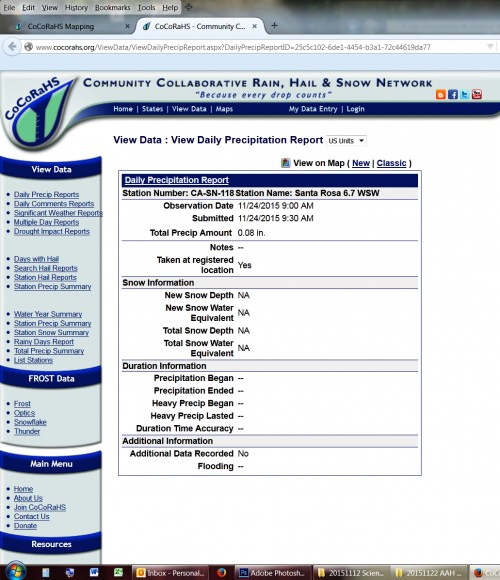 Opening the link “Go to report details” in the map (previous photo).
Opening the link “Go to report details” in the map (previous photo).
At the Habitat Garden
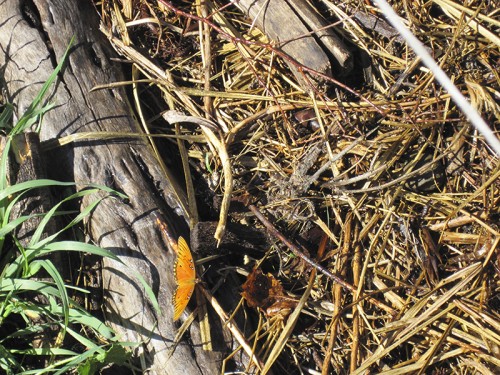 A gulf fritillary in Compost Cricket Corral.
A gulf fritillary in Compost Cricket Corral.
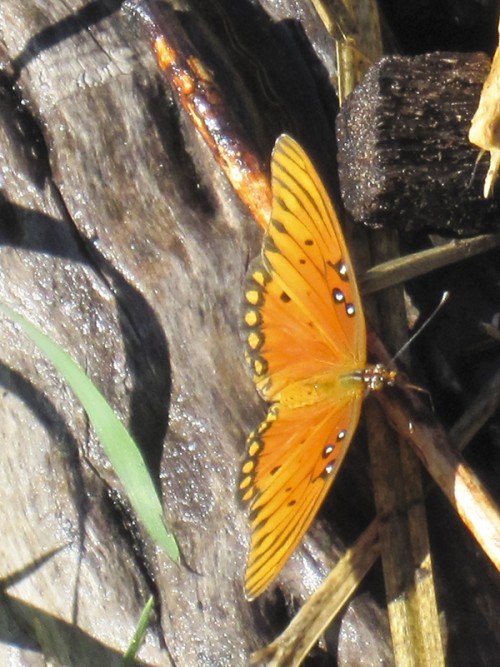 Close-up of gulf fritillary butterfly in Compost Cricket Corral habitat.
Close-up of gulf fritillary butterfly in Compost Cricket Corral habitat.
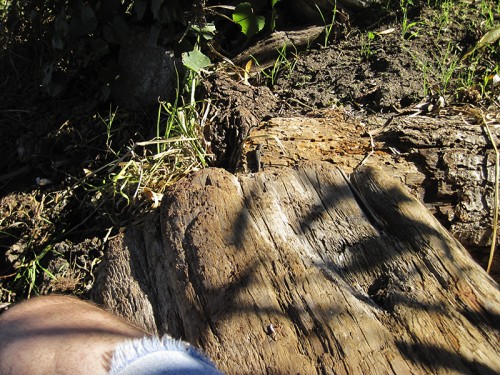 A western fence lizard peeks out of the sitting bench in Salamander French Drain habitat.
A western fence lizard peeks out of the sitting bench in Salamander French Drain habitat.
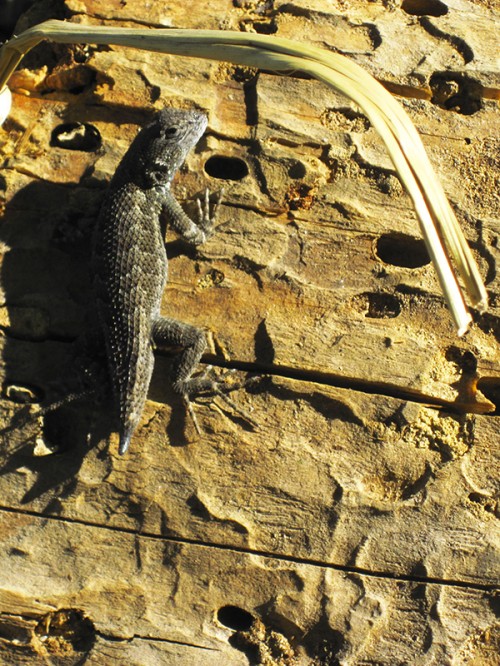 Close-up of the lizard that was under the sitting bench. Note the contour and holes that insects carved into the wood of Salamander French Drain’s retaining wall. The wood surface itself is habitat for tiny critters, some of which might be prey of the lizards. Also note the blunt tail of the lizard — this lizard escaped a predator, leaving the predator with the broken off and wiggling tail section. The “tail drop” is called caudal autonomy. Lost a tail but granted another life!
Close-up of the lizard that was under the sitting bench. Note the contour and holes that insects carved into the wood of Salamander French Drain’s retaining wall. The wood surface itself is habitat for tiny critters, some of which might be prey of the lizards. Also note the blunt tail of the lizard — this lizard escaped a predator, leaving the predator with the broken off and wiggling tail section. The “tail drop” is called caudal autonomy. Lost a tail but granted another life!
Much appreciation to the Laguna Foundation, especially Restoration and Conservation Science Department staff Wendy Trowbridge (Director), Brent Reed (Manager), Aaron Nunez (Tech II), and Paul Weber (Tech). And thank you, Estrella Phegan, Nursery Manager, for sharing the space.
Enjoy your outdoor classrooms and wildlife habitat gardening.
Tony

